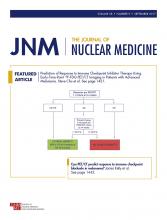REPLY: We thank Drs. Thie, Laffon, and Marthan for their response on our paper (1). In this study, we tried to comprehensively investigate the repeatability of various whole-body 18F-FDG uptake metrics and assess the influence of several correction methods to normalize 18F-FDG uptake.
In their letter, Drs. Laffon and Marthan discuss the advantages and disadvantages of a dynamic and test–retest study design for the assessment of 18F-FDG repeatability. We fully agree that measurement uncertainty of all quantitative PET metrics should be determined. As stated, a dynamic design may be particularly suitable when assessing the role of statistical noise on variability of individual PET/CT systems. Yet, we would like to emphasize that a test–retest study is needed for the assessment of repeatability in a response evaluation setting in which patients are scanned at different occasions. A true test–retest design is the closest approximation of the clinical conditions met during response assessment and includes all sources of variability encountered in clinical practice, such as variability in injected activity, uptake time, physiologic status, patient repositioning, and breathing-induced artifacts. These results can be used to determine thresholds that are able to differentiate metabolic response and progression from intrinsic measurement variability of quantitative uptake metrics after the start of treatment.
We also want to point out that differences in 18F-FDG uptake measures due to variation in uptake time are caused by differences in 18F-FDG kinetics at 60 and 90 min after injection and not physical decay of 18F (2). Omitting physical decay correction to correct for differences in uptake time between 2 scans falsely assumes that 18F decay and 18F-FDG kinetics are proportional. This uptake time correction method should therefore not be used in a longitudinal setting because of physiologic variations in 18F-FDG kinetics.
In addition, we assessed the effect of several 18F-FDG uptake normalization methods, including one for glucose correction, on repeatability. In the current cohort, all plasma glucose levels (4.5–7.1 mmol/L) were well within the recommended range and showed a low interscan variability (≤2.2 mmol/L) (3). The influence of competing endogenous glucose on 18F-FDG uptake metrics was thus likely to be limited. However, by correcting tumor uptake for glucose correction a potential source of measurement variability is also introduced. This is supported by the finding that the median difference of repeated glucose level measurements in the same patient, using a calibrated device, was 0.2 mmol/L (0–0.8 mmol/L) in this study. We would therefore suggest that glucose correction should not be performed if glucose levels are within the reference range, as also noted by Dr. Thie in his letter. We would like to encourage Dr. Thie and colleagues to study the influence of other (more complex) glucose-correction methods on the repeatability of 18F-FDG uptake metrics in a cohort with a higher variability in plasma glucose levels. This is of particular interest for metastatic diseases because a wide variety of tissues can be affected.
Footnotes
Published online Jun. 15, 2017.
- © 2017 by the Society of Nuclear Medicine and Molecular Imaging.







